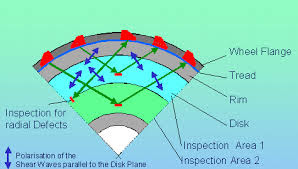Ultrasonic Inspection (UT) is a method of NDT that is used
to detect internal anomalies in a part, which may contain welding, or stress
defects that can be detrimental to the integrity of thecomponent. It is also a
commonly accepted method of checking the wall thickness of pipelines and
vessels, which are suspected of being eroded internally, when access is limited
to one side of the material. UT is very sensitive to critical defects in a
material like cracks, welding defects, porosity, lack of fusion and inclusions,
which may weaken the weld. It is also very portable and can be used on a wide
range of materials. This method of inspection,
though, is very reliant on having an experienced and well-trained
Inspector to interpret the indications they come across in field conditions and
to determine if the part is satisfactory or if remedial action is required.
Ultrasonic flaw detection is basically a comparative
technique. Using appropriate reference standards along with knowledge of sound
wave propagation and generally accepted test procedures, a trained operator
identifies specific echo patterns corresponding to the echo response from good
parts and from representative flaws. The echo pattern from a test piece may
then be compared to the patterns from these calibration standards to determine
its condition. Sound waves are simply organized mechanical vibrations traveling
through a medium, which may be a solid, a liquid, or a gas. These waves will
travel through a given medium at a specific speed or velocity, in a predictable
direction, and when they encounter a boundary with a different medium they will
be reflected or transmitted according to simple rules. This is the principle of
physics that underlies ultrasonic flaw detection.
Ultrasonic Inspection uses very short duration sound pulses which when included
into a material reflects off different media i.e. air interfaces and
inclusions. The time for the reflection from these media are monitored and
compared against the known travel speeds for the given material. The careful
measurement of these pulse times becomes a measure of the distance the pulse
has travelled and these are monitored via signals on a visual display screen.
These signals may represent cracks, back wall echo and lack of fusion (common
air interfaces), slag, tungstenand copper (common welding inclusion). The
tracking of these signal levels during the inspection enables the inspector to
gather information about the size, type and location of the anomalies detected.
During wall thickness monitoring of pipelines and vessels where access is
limited to one side only, the sound pulse reflects off the inner wall of the
component. These signal times become a measure of the distance travelled and
any internal erosion/corrosion can be detected due to a reduction in wall
thickness (a faster signal time
Advantages of Ultrasonic Inspection
- High sensitivity to both surface and subsurface discontinuities, permitting the detection of extremely small flaws.
- Greater accuracy than other nondestructive methods in determining the depth of internal flaws and the thickness of parts with parallel surfaces.
- Nonhazardous to operations or to nearby personnel and has no effect on equipment and materials in the vicinity.
- Capable of portable or highly automated operation.
- The depth of penetration for flaw detection or measurement is superior to other NDT methods.
- Only single-sided access is needed when the pulse-echo technique is used.
- It is highly accurate in determining reflector position and estimating size and shape.
- Minimal part preparation is required.
- Electronic equipment provides instantaneous results.
- Detailed images can be produced with automated systems.
- It has other uses, such as thickness measurement, in addition to flaw detection.
source : eurondt.com and ndtindia.org

I would say that Ultrasonic flaw detection is an important part of ultrasonic inspection and help a lot in providing accurate results in ultrasonic testing and ultrasonic inspection is just incomplete without it.
ReplyDeleteThanks for sharing the post.
ReplyDeleteJust visit our site at:
http://www.sigmatest.org/Ultrasonic-test-Concrete-Delhi.html
Ultrasonic Inspection (UT) is a method of NDT that is used to detect internal anomalies in a part, which may contain welding, or stress defects that can be detrimental to the integrity of thecomponent. GE USM Go
ReplyDeleteYou have explained well for ultrasound inspection flaw detection, well done! For how to become an ultrasound tech, visit this website.
ReplyDelete